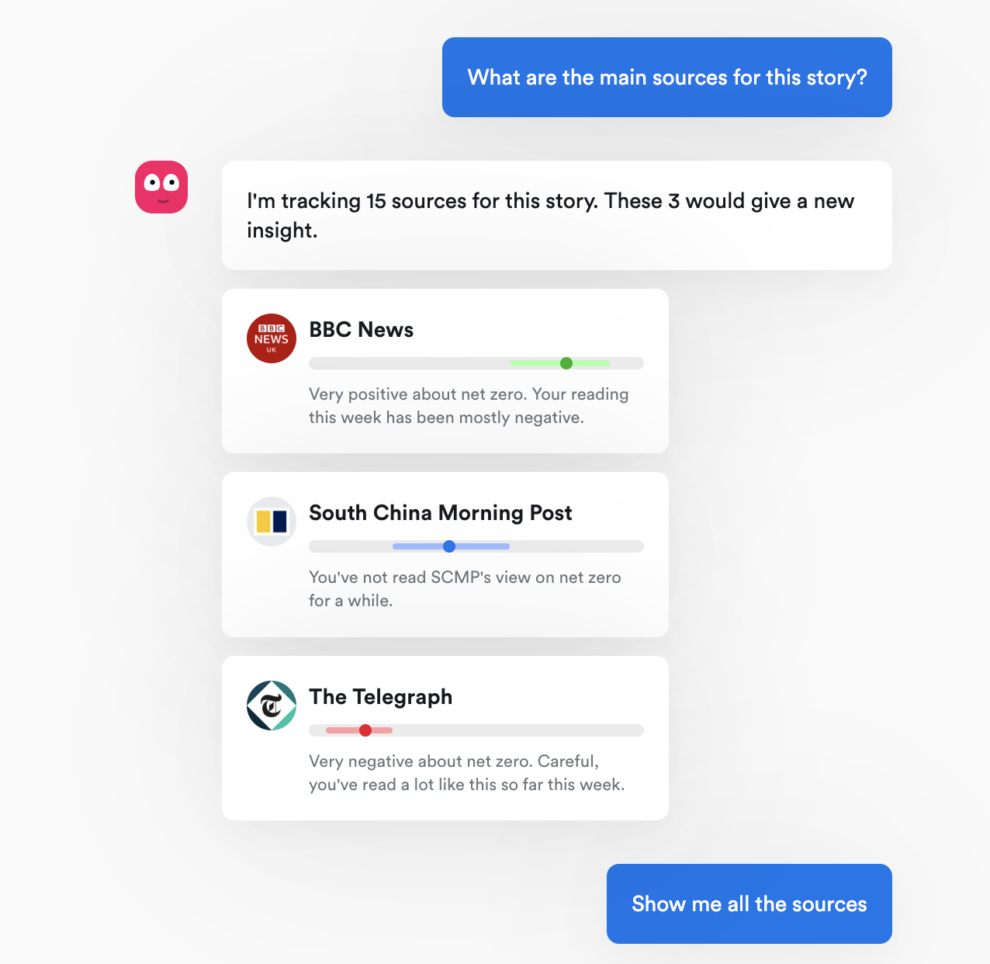The debate on how Generative AI will impact journalism has been very active since the launch of ChatGPT in November.
Some organisations embraced the technology, some developed tools to detect AI generated content (including OpenAI themselves) and some are defending that human curated journalism will become even more valuable in a world of AI made content.
While the debate is ongoing, technologies continue to evolve and new tools are being launched every hour in the Wild West of Generative AI. We hand picked 10 examples of experiments done with Generative AI, 5 from news organisations and 5 from tech enthusiasts on a mission to build the next big thing in news.
5 Early experiments with AI generated news
NewsGPT
Entirely AI-generated, the NewsGPT website curates and distributes AI-generated news stories. Articles and images are created without any human involvement. Readers can also subscribe to a daily AI-generated newsletter and choose preferred news categories to receive regular updates on.
The team behind NewsGPT aims to provide fast and reliable news, free from any human biases or errors. First launched in February 2023, the site covers a wide range of topics, including technology, finance, politics, and entertainment.
However, the site doesn’t quote any sources and articles are mainly short, context and unstructured.

Eto News – Stories from different sources summarised daily
Synthesising the reporting on similar stories from a variety of outlets, Eto News seeks to use AI to clear out bias that stems from being subscribed to a singular news source.
Eto News is built on Substack. Every day, five news outlets are selected and 3 stories published by these news outlets are picked and summarised with the use of Eto, a tool powered by ChatGPT.

The team behind Eto is open about the potential downsides of their technology, asking open feedback from readers in case of errors: “Have you noticed any mistakes or biases in our work? We welcome your feedback”
Is this story capturing your attention?
"(Required)" indicates required fields
Artifact – AI curated feeds with gamified experience
Released late last year by Instagram’s co-founders, Artifact is a mobile app serving AI-driven personalized news feeds to help readers find the best articles tailored to their individual interests. The app went out of beta this month and is now available on both iOS and Android platforms.
Artifact curates news from a variety of free and paid sources. Readers can add their ‘paid subscriptions’ during the sign-up process and the algorithm will prioritise articles from those sources in the feed. Artifact was downloaded more than 50.000 times and has high rating (4.7/5) in the stores.


An innovation brought by Artifact is the very transparent communication about how their personalisation works and the gamified experience with streaks and levels.
Additionally, the app incorporates social media elements that bring some nostalgia of early experiments with new news products like Flipboard. Readers can invite friends and see what’s trending in the friends’ network.
Charlie – A personalised news chat bot
Made by UK based digital news platform OneSub who is known to experiment with AI in news creation and distribution, Charlie is a conversational AI that can give news headlines from both smaller, independent publishers as well as larger national and international websites.
It’s quite fun to use, but it does require some interaction to get to the depth of news. Charlie also provides a view on its sources.



Aside from Charlie, OneSub is also experimenting with the Nuz platform aiming to generate summary videos from text. The tool’s functionality is still very limited.
Generative Press – News written by 4 different “AI Journalists”
Created in a weekend by two colleagues at Serendipity, The Generative Press is written entirely by 4 “AI journalists” drawing on twitter and popular news sites. There is no human intervention or editorial team involved in the process.
These 4 AI journalists have distinct personas with the aim to give a different tone of voice to the articles depending on their AI authors.

While such personas can be beneficial in understanding cross generational content creation (a topic we are addressing in this year’s Digital Growth Summit), it is still very early on the journey to creating value adding journalism.
For instance, when experimenting with the tool our team found the 13 year-old “AI Journalist” Jake Ryan to describe a recent helicopter crash during the war in Ukraine as ‘dis be a damn shame’ in an article that lacks coherence and sensitivity on the topic.
5 Publishers taking steps with Generative AI
Publishers have also been keen on learning more about Generative AI technologies. Experiments were ran in both Europe and the US to help newsrooms translate, personalise and publish content.
- Le Monde – Using Automated Translations with Human Oversight
- French publication Le Monde launched an English edition last year with help from an AI-powered translation platform.
- Initial versions of articles are mainly translations of the French articles done with the help of an artificial intelligence tool. Final editing of the articles remains in the hands of English-speaking journalists.
- Il Foglio Quotidiano – Making AI into a game for readers
- Italian publication Il Foglio Quotidiano had a very original idea.
- They started a game where for 30 days they will publish articles written with ChatGPT.
- Every week, 2 readers who correctly identify these articles will be awarded a subscription and a bottle of champagne.
- The aim of the initiative is to highlight new technologies while incentivising readers to reflect on the balance between man and machine in journalism.
- Daily Mirror – Using automated articles for utility journalism
- Reach PLC titles the Daily Mirror and the Daily Express published their first articles from ChatGPT in March 2023.
- The articles were posted on Reach website InYourArea.co.uk and featured local to-do guides such as this piece on 7 things to do in Newport under guidance from editorial teams.
- Reach PLC’s Chief Executive Jim Mullen said that in story areas based on data, like the “things to do” format, weather and “what’s local traffic like?”, AI could prove reliable enough to take over the production of content and leave journalists to focus on harder hitting content.
- Wired – transparent communication to readers about AI using plans
- Wired were able to offer their readers radical transparency by publishing an official AI policy. In the policy, published by their Global Editorial Director Gideon Lichfield, they outlined all the ways in which they plan to use AI.
- These uses included headline suggestions, social media posts and story ideas but not publishing AI written or edited texts or AI generated images or videos.
- Medium was also one of the first one to publish guidelines on the use of Generative AI tools for their writers.
- Semafor – putting chatbots to the test
- Semafor’s Gina Chua believes that ChatGPT and other AI systems can’t do journalism well because they weren’t built for this. They were built as language models, so naturally they’ll be good at tasks involving language.
- Semafor asked chatbot Claude to copyedit stories in which they have deliberately introduced factual errors along with spelling and grammar mistakes. Unsurprisingly for a language model, it aced the test.
Do we need a break?
There is no doubt that Generative AI can be a great helping hand in every day tasks. According to a 17,000 people survey run by The Conversation, people’s level of comfort with using AI to help perform administrative or job-related tasks is as high as 65%.
But while experiments like the ones highlighted show clear promise and are very important for learning and fostering innovation, we are still early on in the journey to generating real value.
US tech news website CNET was one of the first ones to adopt AI generated articles in late November last year. 77 AI-generated stories were published by the outlet between November 2022 and January 2023. But recently, the publisher was forced to issue corrections for 41 of these stories. They have decided now to pause AI experimentation and undertake an internal review on the ability of AI to generate accurate stories.

A similar movement was announced at larger scale earlier this week, when more than 1300 tech leaders have signed an open letter to ask all AI labs to “pause the AI development race“ for at least 6 months, in the hope this will give time for planning and management.
Did you find this story interesting?
"(Required)" indicates required fields
Other Blog Posts

Stay on top of the game
Join our community of industry leaders. Get insights, best practices, case studies, and access to our events.
"(Required)" indicates required fields

